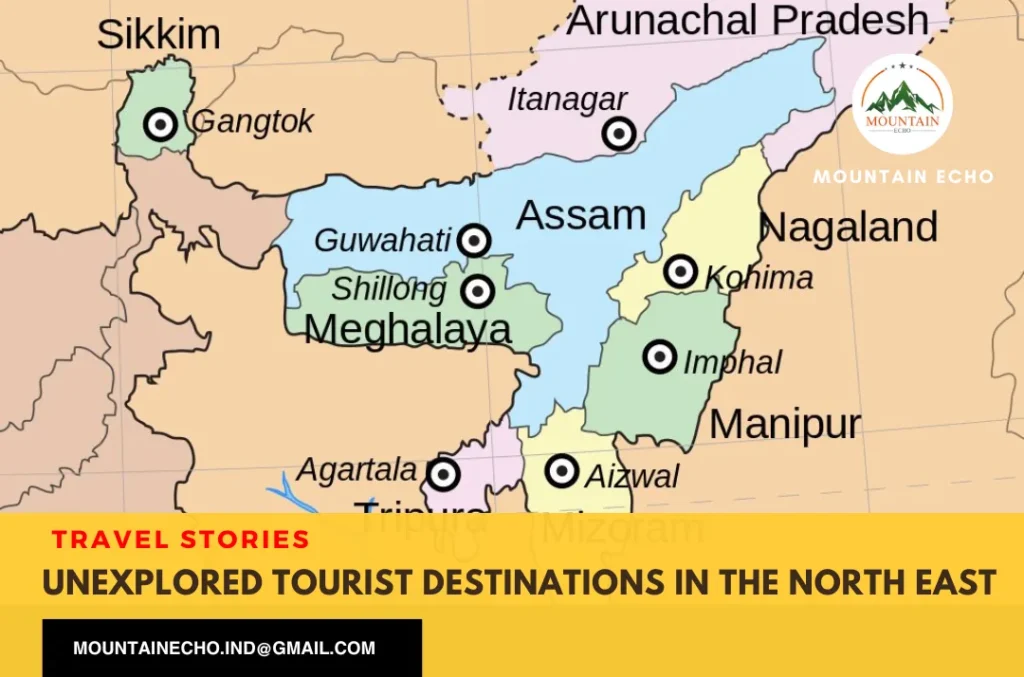North East India: Unexplored tourist destinations
WhatsApp Channel
Join Now
The North East of India is like a hidden gem waiting to be discovered. It’s a lovely area that not many people have had a chance to explore yet. This part of India is full of amazing places for tourists to visit. The scenery here is absolutely stunning, with beautiful hills and colorful landscapes. The people here have different traditions and a really interesting culture that adds to the charm of the place. It’s truly one of the most amazing spots in the whole world. So, let’s take a closer look at some of the lesser-known tourist spots in the North East of India.
Arunachal Pradesh: Vijaynagar
Vijaynagar is the easternmost inhabited area of North East India, located in Arunachal Pradesh. It’s a remote place surrounded by Myanmar on three sides and a forest on the other side. The area has natural beauty and is surrounded by the Namdapha National Park. The nearest towns are Miao, Hayuliang and Tezu.
Vijaynagar has 16 villages with around 4500 people. The residents rely on wetland and jhoom cultivation for their livelihoods. Lack of road connection makes the region heavily dependent on irregular military helicopters for essential supplies and services. Despite challenges, Vijaynagar is crucial to India’s Look East Policy due to its proximity to Myanmar and its potential for strategic influence.
The region has potential for eco-tourism due to its natural beauty and unique species. Life in Vijaynagar is peaceful to live though there exist the threat of foreign intrusion. A significant portion of the population (55%) consists of retired Gorkhas of the Assam Rifles, while the rest are mainly civilians, including the Lisu (Yobin) people.
Assam: Majuli
Majuli is the world’s largest river island, situated in the Brahmaputra River. The island’s vibrant culture and dynamic lifestyle make it a popular destination for travelers. Majuli is seen as the social capital of Assam, India. Festivals celebrated here are lively and dynamic, with the Raas festival being a major attraction.
Majuli covers an area of 1250 sq km and it’s even larger than Marajo in Brazil. It is a strong contender for UNESCO World Heritage Site status due to its unique tribal-controlled lifestyle. The name Majuli means ‘the land between two parallel streams,’ formed by the Brahmaputra River and its tributaries. However, due to the river’s changing course, the island’s existence is at risk.
The island faces threats from constant erosion and flooding. These factors have led to a significant reduction in its size. There are concerns about whether the Brahmaputra River will cause the island to disappear by 2030. It is advisable for visitors to explore this beautiful island before it disappears due to natural processes.
Manipur: Nilai Tea Estate
Located in Talui, Manipur, Nilai Tea Estate is the only tea estate in the region. It produces high-quality tea using traditional methods. The estate’s tea is known for its rich aroma and flavor upon the second boil. The traditional method involves withering, rolling, fermenting, drying, and sorting the tea leaves.
The climate and soil conditions are ideal for growing medicinal-enriched black and green tea. The tea is mainly supplied to local markets due to limited production. The estate believes that with government support, it can export its tea to other states and even foreign countries. Tourists can visit the estate, learn about the tea-making process, sample the tea, and purchase it directly.
The Nilai Tea Estate reflects the natural beauty and cultural heritage of Manipur. Despite challenges, it remains a source of pride. Visiting Nilai Tea Estate provides an opportunity to enjoy tea, nature, and cultural richness. It’s a unique and unforgettable experience. Talui is a nearby township surrounded by beautiful mountain ranges. It offers stunning natural beauty and panoramic views.
Meghalaya: Kognthong
Kongthong is a charming village in Meghalaya where people communicate mostly through whistles instead of talking. This unique tradition is a significant part of their culture. People in Kongthong use whistles for conversations and even have melodious whistling tunes as names. This tradition has been passed down for generations and is a way to connect with nature and each other.
The people of Kongthong belong to the Khasi tribe and have been using whistling to communicate for a long time. They create distinct whistled names for individuals based on their characteristics. Surrounding natural sounds like rustling leaves, flowing water, and animal noises might have influenced the development of their whistling language.
Visitors to Kongthong can experience a unique cultural phenomenon where people converse using whistles. The village is set in a beautiful natural environment with green fields and misty hills. Kongthong’s whistling tradition is gaining attention, and efforts are being made to protect and promote this cultural heritage. Modernization and changing lifestyles pose challenges to preserving this tradition.
Mizoram: Phawngpui
Phawngpui or the Blue Mountain is the highest peak in the state of Mizoram. It’s located in Lawngtlai district near the southeastern border of the state. It overlooks the bend of the Chhimtuipui River and Myanmar’s hill ranges. The Peak is one of the most amazing and yet unexplored destinations in North East India.
The peak’s height is 2157 meters and on the top of it there is a level ground of about 2 square km. The ridge extends for about 10 km from north to south. It’s surrounded by steep and high cliffs, with the most impressive one being Thlazuang Kham.
The region has a wide variety of flora and fauna and has been declared as a National Park. The ridge looks like a garden with many colorful flowering trees such as rhododendrons and orchids. Birds like the Blyth’s Tragopan, Dark Rumped Swift, and Hume’s pheasant live here. There are also endangered animals like the Slow Loris, Tiger, Leopard, and more.
Nagaland: Kiphire
Known as the “Land of Minerals” due to rich mineral deposits. Sharing borders with Assam and Myanmar, Kiphire has coal, limestone, nickel, chromite, and high-quality graphite deposits. The region’s graphite is top-quality and used in making lubricants, pencils, batteries, and more.
Kiphire’s limestone is used for cement production and is of high quality, making the North East region a major supplier. Nickel and chromite deposits are used for stainless steel and alloy production. The mineral-rich deposits make Kiphire significant for the mining industry, attracting mining companies. Recent studies suggest possibilities of valuable minerals like gold and platinum.
Kiphire offers natural beauty, pristine forests, and diverse cultures. Kiphire is home to tribes like Sangtam, Yimchunger, and Sumi, each with unique cultures. The district offers adventure activities like rock climbing, rappelling, and river rafting. Beautiful waterfalls like Salomi and Likhimro provide places for swimming and relaxation. Alongside its mineral wealth, Kiphire’s tourism potential contributes to the region’s economy.
Sikkim: Tarey Bhir
Located near Sadam in Namchi district, South of Sikkim, it’s a picturesque cliff overlooking the confluence of Teesta and Rangeet rivers, Himalayas, Kalimpong town, and Peshok tea garden. The cliff is around 10,000 feet high and offers stunning views of the Himalayas, valleys, and surrounding areas.
Tarey Bhir hosts various bird species, including the endangered black-necked crane, and sometimes the elusive Bharals (blue sheep) grazing on the slope. The cliff’s slope has green pines, and the right side is covered with grass, moss, and shrubs. There’s a paved walkway along the ridge leading to a temple called Devi Thaan Mandir, surrounded by pine-tree forest.
Stories exist of people falling off the cliff while collecting grass for cattle, yet locals still risk it due to their needs. Despite its beauty, Tarey Bhir isn’t well-known among tourists. It’s perfect for nature lovers, birdwatchers, meditation, and relaxation.
Tripura: Neermahal
Neermahal is a beautiful palace in the middle of Rudrasagar Lake. It was built by a king named Maharaja Bir Bikram Kishore Debbarman Manikya for his family’s summer home. The Maharaja belonged to the Manikya Dynasty, which is considered the second-longest single-line dynasty in the world.
This palace is special because it’s surrounded by water and is the biggest water palace in India. It’s a mix of Hindu and Mughal architecture styles and is located in Melaghar, not far from Agartala, the capital of Tripura. Neermahal is made using marble and sandstone, which makes it very elegant.
The palace has two parts. The western side, called Andar Mahal, was for the royal family. The eastern side was an open-air theater for cultural events enjoyed by the Maharajas and their families. The palace has a total of 24 rooms. Every August, a festival called Neermahal Water Festival takes place at Melaghar and Rudrasagar Lake. There are cultural shows and events, and the main highlight is a boat race on the lake.
Telegram Channel
Join Now



